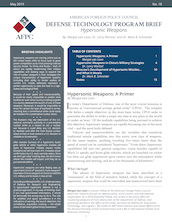The advent of hypersonic weapons has been described as a “renaissance” in the field of missilery.Indeed, while the concepts of a supersonic weapon that could be controlled and maneuvered have been studied for decades, translating them into development and production has only now become feasible thanks to recent technological advances. Any country seeking to count hypersonic weapons among its military capabilities can anticipate a number of crucial advantages, all related to an increased degree of uncertainty posed by these weapons to an adversary in the event of a conflict. To start, the velocity with which hypersonic weapons would be able to reach their targets reduces the adversary’s ability to either relocate or respond before the strike occurs. Meanwhile, the weapons’ maneuverability allows them to travel on unpredictable trajectories, making it difficult to track and destroy them before they successfully penetrate advanced air and ballistic missile defenses. Lower signatures and an ability to fly at lower altitudes also compound the challenge of finding, targeting, and intercepting hypersonic vehicles for current missile defense systems like the Ground-Based Interceptor (GBI), Terminal High Altitude Area Defense (THAAD), and Patriot. The fact that these vehicles can carry either nuclear or conventional warheads adds another element of uncertainty to an already unpredictable threat. In short, hypersonic technologies are changing the game. As Dr. Mike Griffin, DoD’s Under Secretary for Research and Engineering, has noted, “this is not an advantage that we can concede to people who wish to be our adversaries.”....
Want these sent to your inbox?
Subscribe
Hypersonic Weapons
Related Categories:
Arms Control and Proliferation; Military Innovation; Missile Defense; Science and Technology; Warfare; China; Russia

